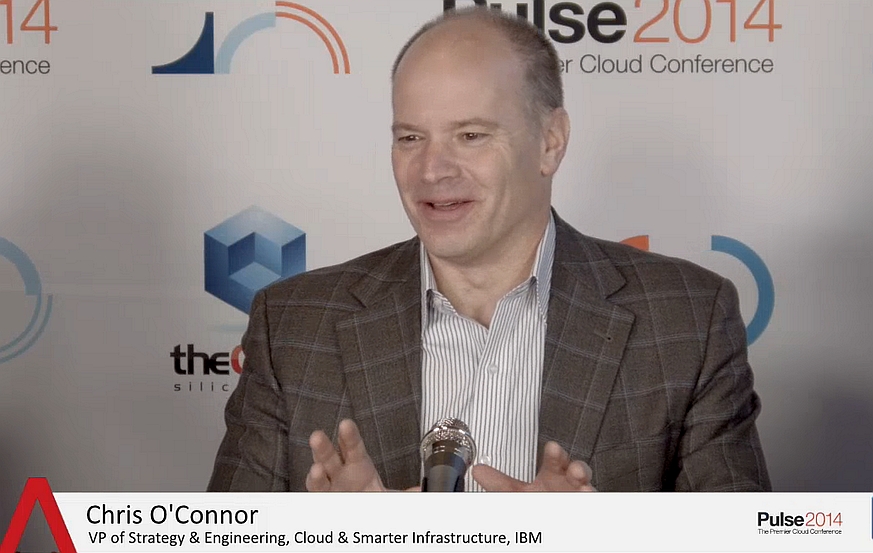 NEWS
NEWS
 NEWS
NEWS
 NEWS
NEWS
![]() John Furrier and Dave Vellante, theCUBE co-hosts, traveled to IBM Pulse 2014 in Las Vegas to talk to the brightest minds in the industry about the optimization of the world’s business infrastructure and about asset management that could drive innovation and increase profitability.
John Furrier and Dave Vellante, theCUBE co-hosts, traveled to IBM Pulse 2014 in Las Vegas to talk to the brightest minds in the industry about the optimization of the world’s business infrastructure and about asset management that could drive innovation and increase profitability.
Chris O’Connor, VP of Strategy & Engineering for the Cloud & Smarter Infrastructure at IBM, joined them in theCUBE to talk more about the recently announced ‘service management.’
“What is IBM’s definition of ‘Service Management’?” asked Furrier.
“When I think about Service Management, I think about a full process life-cycle around the necessary components to support your total production environment, whether you’re a retailer, a distributor or a phone maker,” stated O’Connor. “Whatever you do, it’s being able to manage your servers, your life-cycles, your people, the automation that goes along with it, the virtual processes around your databases, stores and applications, as well as being able to run the continuity of all those things together,” he explained.
IBM Service Management offers the control and automation needed in delivering quality services, maximizing return on investments and accelerating business growth.
.
“Hypercloud is the strategy for the enterprises, but pulling it all together is a challenge,” said Furrier. “What are you doing on the service management side to make that easier?”
“The first thing you have to do about hypercloud is to embrace it,” joked O’Connor. “That’s one of the big steps we’re taking here at the show today. We’re introducing the ability to understand what you need to optimize and where you need to innovate. Then you can look at the Capex / Opex trade-off of blending those different capabilities together.”
“We’re not replacing things; we’re adding ‘as a Service’ capabilities to our portfolio,” said O’Connor.
“Do you agree that it was hard, historically, for the CFOs to justify the investment in service management, specifically within IT, and is that changing?” asked Vellante.
“People understood they needed to make the investment. The’ve been looking at the speed of value that they could get back. That became the struggle,” said O’Connor.
He continued: “One of the things we’re doing with our service management, as it becomes an ‘as a Service’ delivery, is allowing people innovate very quickly. You can get started and implement quickly. And because of the Capex / Opex trade-off, you can rent and experiment before deciding if you want to purchase later on.”
“There’s an adjacent line of business disciplines, similar in dynamics with the IT service management. Where is IBM in terms of bringing that discipline out toward the business?” asked Vellante.
“An affectionate term could be ‘shadow IT’,” thinks O’Connor. “We’re seeing all the time when someone is trying to innovate quickly. Our ‘as a Service’ offerings are designed for these people to plug in and focus on innovation.”
“What about developing apps on top of the core service management platform?” inquired Vellante. “Is that where the BlueMix comes in?”
“People are moving to a composable application development environment: BlueMix, launched here at the show. The BlueMix environment is going to need composable management elements inside of it as well; as you build your app, you are pre-instrumenting for service management to be applied right on top,” said O’Connor.
.
“It’s a growing market in the traditional IT space and it continues to grow. The entire need for the structure is being able to manage components ‘as a service.’ That is an area where we are investing, and also in the internet of things: the digitalization of everything. All of those things emitting tremendous amounts of information become part of the same life-cycle of being able to understand whether your assets are delivering value. The service management is about making sure the assets of your business are delivering the value to what it is you produce. The Internet of Things connectivity is real. We’re using the same service manage paradigm to manage a whole range of devices, to keep them up, running and healthy, and we use analytics to figure out in advance what they are about to do,” detailed O’Connor.
“You have gamification, analytics, predictive analytics, how is all that integrate into the service management portfolio?” asked Furrier.
Connor thinks the world is instrumented in an incredible way. “We have buckets of data sitting around everywhere; people collect it but they don’t quite know what to do with it,” he noted. To help people solve that predicament, IBM is launching some of the capabilities of IBM Watson, which allows them to reduce it to a math problem.
Make sure you watch the entire segment to catch Chris O’Connor’s explanation of cognitive computing and how it helps making better decisions by understanding the
complexity of Big Data.
THANK YOU